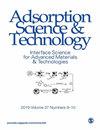Capacitive Deionization for the Removal of Paraquat Herbicide from Aqueous Solution
IF 2.8
4区 工程技术
Q2 CHEMISTRY, APPLIED
引用次数: 6
Abstract
In comparison to other conventional methods like adsorption and reverse osmosis (RO), capacitive deionization (CDI) has only been investigated extensively for the removal of inorganic pollutants from water, demonstrating limited practicality. Herein, the study investigated the use of CDI for the removal of paraquat (PQ) herbicide from water by using commercial activated carbon (AC) electrodes. The CDI performance was examined as a function of the initial PQ concentration, applied voltage, flowrate, treatment time, and cycle stability testing in the batch mode approach. The applied voltage had a beneficial effect on the removal efficiency, whereas the removal efficiency of PQ declined as the initial PQ concentration increased. However, the electrosorption capacity gradually increased with the increase of initial feed solutions’ concentration. The maximum removal efficiency and electrosorption capacity achieved at 5 mg/L and 20 mg/L PQ initial concentrations, an applied voltage of 1.2 V, and 5 mL/min flowrate were 100% and 0.33 mg/g and 52.5% and 0.7 mg/g, respectively. Washing the electrodes with distilled water achieved sequential desorption of PQ, and the process produces a waste stream that can be disposed of or treated further. Therefore, the CDI method is considered a promising and efficient method for removing organic pollutants from water including pesticides.电容去离子法去除水溶液中的百草枯除草剂
与吸附和反渗透(RO)等其他传统方法相比,电容性去离子(CDI)在去除水中无机污染物方面只进行了广泛的研究,实用性有限。本研究采用商用活性炭(AC)电极,研究了CDI对水中百草枯(PQ)除草剂的去除效果。CDI性能作为初始PQ浓度、施加电压、流量、处理时间和间歇循环稳定性测试的函数进行了测试。施加电压对PQ的去除率有有利影响,而PQ的去除率随着初始PQ浓度的增加而下降。随着初始进料溶液浓度的增加,电吸附量逐渐增大。在初始PQ浓度为5 mg/L和20 mg/L、电压为1.2 V、流量为5 mL/min时,最大去除率和电吸附量分别为100%和0.33 mg/g、52.5%和0.7 mg/g。用蒸馏水洗涤电极实现了PQ的顺序解吸,该过程产生的废物流可以被处理或进一步处理。因此,CDI法被认为是去除水中包括农药在内的有机污染物的有效方法。
本文章由计算机程序翻译,如有差异,请以英文原文为准。
求助全文
约1分钟内获得全文
求助全文
来源期刊

Adsorption Science & Technology
工程技术-工程:化工
CiteScore
5.00
自引率
10.30%
发文量
181
审稿时长
4.5 months
期刊介绍:
Adsorption Science & Technology is a peer-reviewed, open access journal devoted to studies of adsorption and desorption phenomena, which publishes original research papers and critical review articles, with occasional special issues relating to particular topics and symposia.
 求助内容:
求助内容: 应助结果提醒方式:
应助结果提醒方式:


